RECOIL OFFGRID Preparation Reconnaissance: Training with Guerrilla Mentor
In This Article
Many of you will recognize this timeless quote. Its lesson is simple and profound: Every prepared individual should be acutely aware of his or her own strengths and weaknesses, as well as those of opponents. Self-awareness can be earned through training and feedback from peers, but accurate intel on the enemy isn’t always so easy to come by, especially if that enemy is wise enough to play his cards close to the chest. This is why military strategists throughout history have placed such a heavy emphasis on reconnaissance — the search for information in unknown or hostile territory.
“If you know the enemy and know yourself, you need not fear the result of a hundred battles. If you know yourself but not the enemy, for every victory gained you will also suffer a defeat.” —Sun Tzu, The Art of War
Whether you’re fighting a war or simply trying to pass through a dangerous area safely, this information is absolutely critical to your survival and the success of your mission. Beyond combat zones, reconnaissance skills can help you observe, record, and share important details about your surroundings with your family or friends. This might include the most efficient routes of travel, alternate escape routes, potential danger areas, signs of recent human activity, and ideal observation points or camp sites.
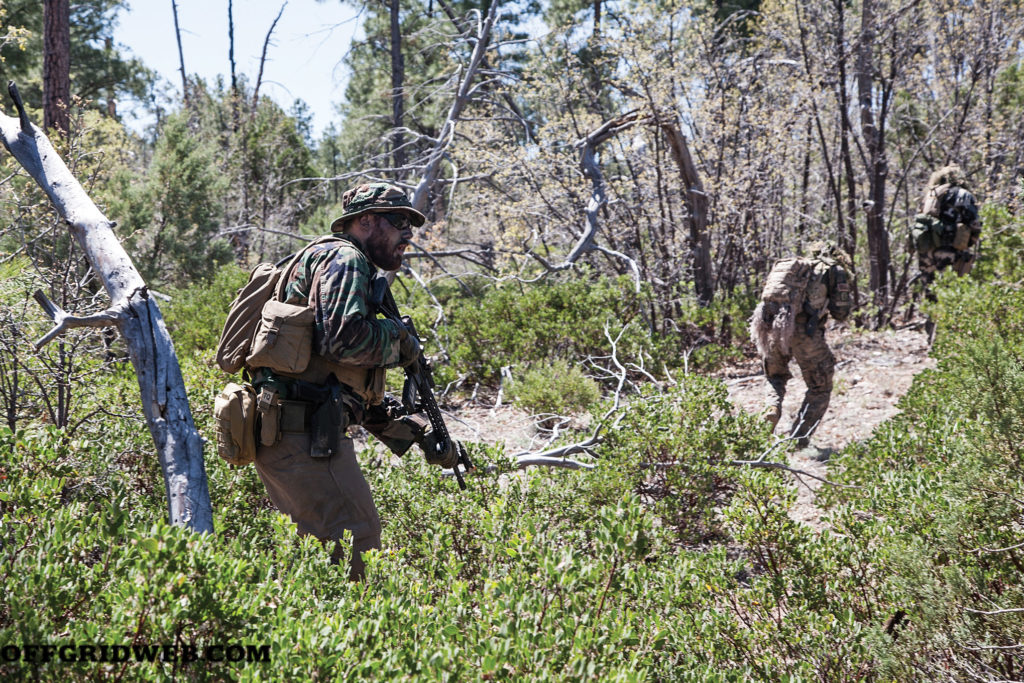
Above: The patrol group moved in a linear formation, maintaining visual contact with their teammates ahead and behind. In areas of denser vegetation, this meant following more closely.
Reconnaissance is frequently taught to members of the military and law enforcement, but the general public is rarely afforded glimpses into this valuable skill set, short of perusing books and field manuals on the topic. U.S. Army FM 3-98 Reconnaissance and Security Operations is a good place to start reading and can be found in PDF format online. However, its tone is dry and academic, and many of the techniques within only apply to established military infrastructure. Most importantly, reading about a subject is never quite as effective as experiencing it firsthand — we wanted to get out into the wilderness and test ourselves.
In order to get some realistic training, we headed up into the White Mountains in eastern Arizona to take a two-day Rural Reconnaissance class with a training organization known as Guerrilla Mentor. As you might guess from the name, Guerrilla Mentor was established with the goal of teaching the principles of a somewhat controversial subject — asymmetric or “guerrilla” warfare — to American civilians, law enforcement, and military personnel. Founder and lead instructor Timothy Lacy has no shortage of experience with this subject. Lacy started out as a U.S. Army infantryman before being assigned to a scout platoon, where he was trained in reconnaissance by Ranger and Special Forces qualified noncommissioned officers. He also spent 16 years in law enforcement, where he applied those same reconnaissance principles to detect and track narcotics production and movement through rural areas. He also spent several years working overseas, including training and leading indigenous forces and working as part of a close protection team. He made it clear that he encourages patriots and prepared civilians to learn and understand these guerrilla tactics because, if America ever finds itself embroiled in a second civil war or “without rule of law” scenario, these are the very same tactics that’ll be employed, just as they’ve been in other conflicts around the world.
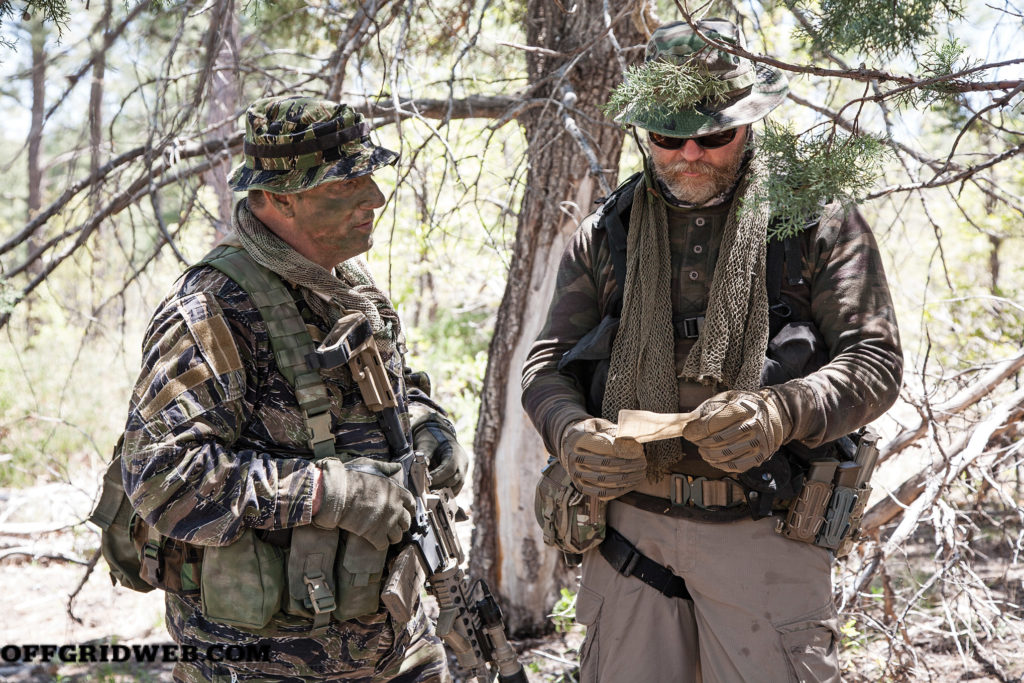
Above: Each member of the team carried a paper map, as well as a notepad for recording observed details about the enemy.
The U.S. Army Ranger Handbook states, “Infantry platoons and squads primarily conduct two types of patrols: reconnaissance and combat.” It’s important to understand the difference between the two, since the goal of a recon mission is to observe the enemy and report back while avoiding conflict. If the mission goes awry and leads to a fight, you should have just enough firepower to break contact and retreat.
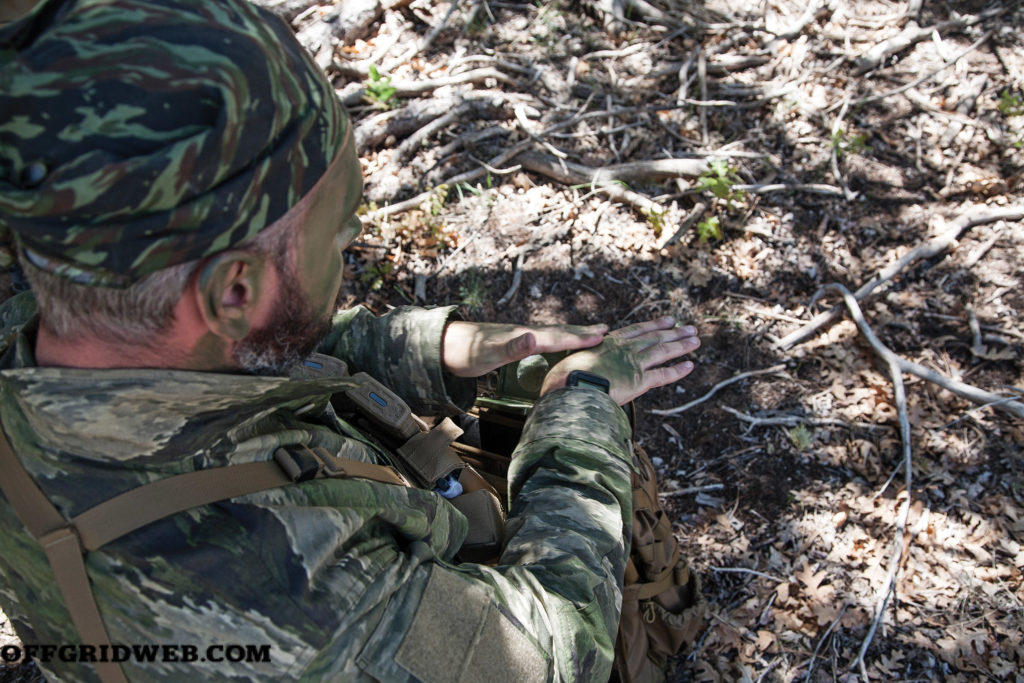

Above: Camouflage grease paint was applied to all exposed skin before the mission. Any reflective items such as watch faces were covered with tape, and gear got a thorough shake-down to check for rattling contents.
On the morning of the first day of the course, students met at a remote campsite among the tranquil pine trees, where we would remain for the next two days. Each student was required to bring a realistic gear loadout — a rifle or carbine with spare magazines, chest rig or load-bearing vest, individual first-aid kit, knife, binoculars, navigation tools, camouflage clothing and grease paint, and a patrol pack to carry it all. We brought our own trail food and water, and slept on the ground in bivvy sacks or under tarps (tents were forbidden).
The first day of the course was focused on teaching students the principles of reconnaissance patrolling; the second day would test those skills as the students set out on a simulated patrol to gather information on enemy forces, a role played by Guerrilla Mentor assistant instructors. Outside of actual hostile territory, this type of force-on-force training is the most true-to-life way to learn. Read on as we discuss each phase of a recon patrol and explain how it applied to our simulated mission during the class.
Before setting foot in the field, gather all existing intel — in rural areas, this will include topographic maps and aerial photos; in urban areas, you might look at social media posts and Google Street View. Eyewitness reports can also provide valuable (but sometimes unreliable) intel. All of this should be combined to formulate a plan that outlines:
During this stage, students in the Guerrilla Mentor class were designated as Recon Team (RT) White Mountain. We were presented with printouts of local topo maps; the remainder of our gear would be the contents of our packs. Eyewitness reports indicated that a group of approximately 10 armed individuals had been looting local homes and businesses in the area. Two to three of these individuals were recently sighted at the top of a small hill nearby, wearing camouflage clothing and traveling in a side-by-side vehicle. They were said to be carrying rifles, binoculars, and what appeared to be a mortar tube. Our mission was to conduct a reconnaissance patrol to confirm enemy presence and activity on that hill. The nearest friendly personnel would be 20 miles away, and no outside comms or fire support would be available.
A reconnaissance patrol typically consists of four to six individuals. Group members move in a predetermined tactical formation (wedge, V-shape, linear, etc.). During movement of this kind, spacing between team members is vital. That space, or interval, should be wide enough that no two people could be injured by a single blast or burst of gunfire, but close enough that each person can still see their teammates to the left and right (or front and rear, depending on type of formation).
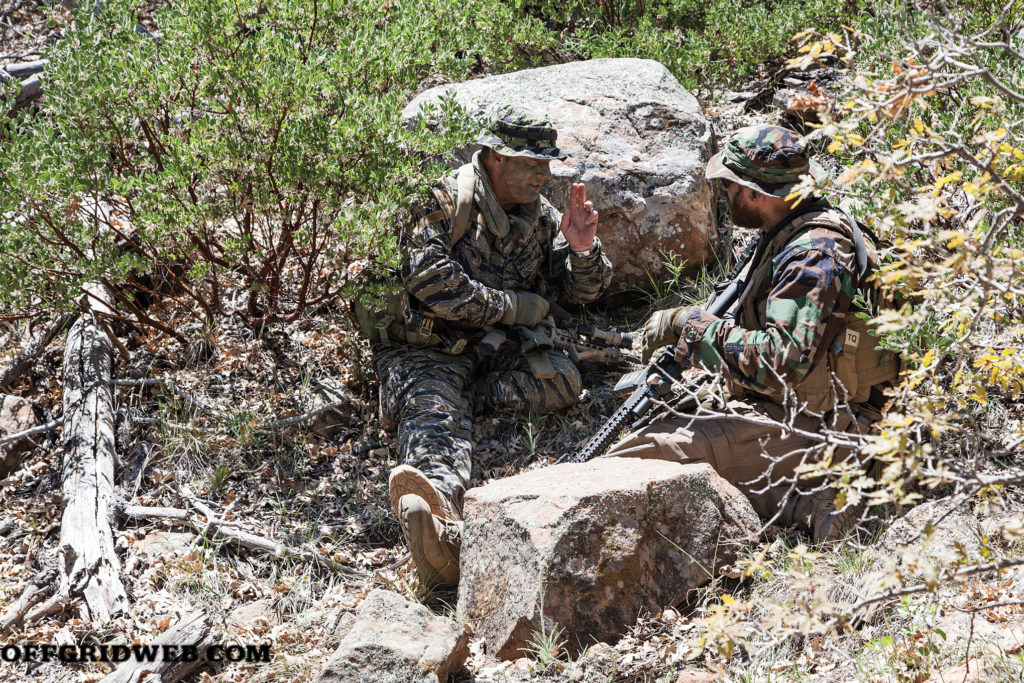
Here are some of the key roles in a proper reconnaissance team, and their primary responsibilities:
Point Man: Always moves ahead of the formation and remains fully observant at all times. If danger is sighted, he uses hand signals to alert the rest of the group. The point man should be rotated out regularly, since this is a mentally taxing role.
Slack Man: Second in line, positioned between the point man and the rest of the formation, provides cover for the point man and watches his blind spots. He periodically checks his compass to keep the group headed in the right direction.
Patrol Leader (PL): A responsible, confident, and experienced member who makes critical decisions and takes responsibility for the success of the mission.
Assistant PL: Helps the patrol leader with routine tasks such as pre-mission gear checks. If the patrol needs to split for any reason, the Assistant PL takes control of one team.
Rear Security: Found at the back of the linear formation, watching and listening for any signs of danger, much like the Point Man. This role is often filled by the Assistant PL.
Additional roles: The Pace Man counts paces to track total distance traveled and determine proximity to rally points and objectives. The Drag Man will drag or carry any injured member of the team to the medevac point. A Radio Telephone Operator (RTO) manages communication beyond the patrol group, if applicable.
Any other members of the group serve as 360-degree security and should periodically rotate into the point, slack, and rear security roles.
In military context, infiltration is defined as “The movement through or into an area or territory occupied by either friendly or enemy troops or organizations. The movement is made, either by small groups or by individuals, at extended or irregular intervals. When used in connection with the enemy, it infers that contact is avoided.” It sounds elaborate but can be as simple as a drive down a dirt road and a short hike, as was the case in this class.
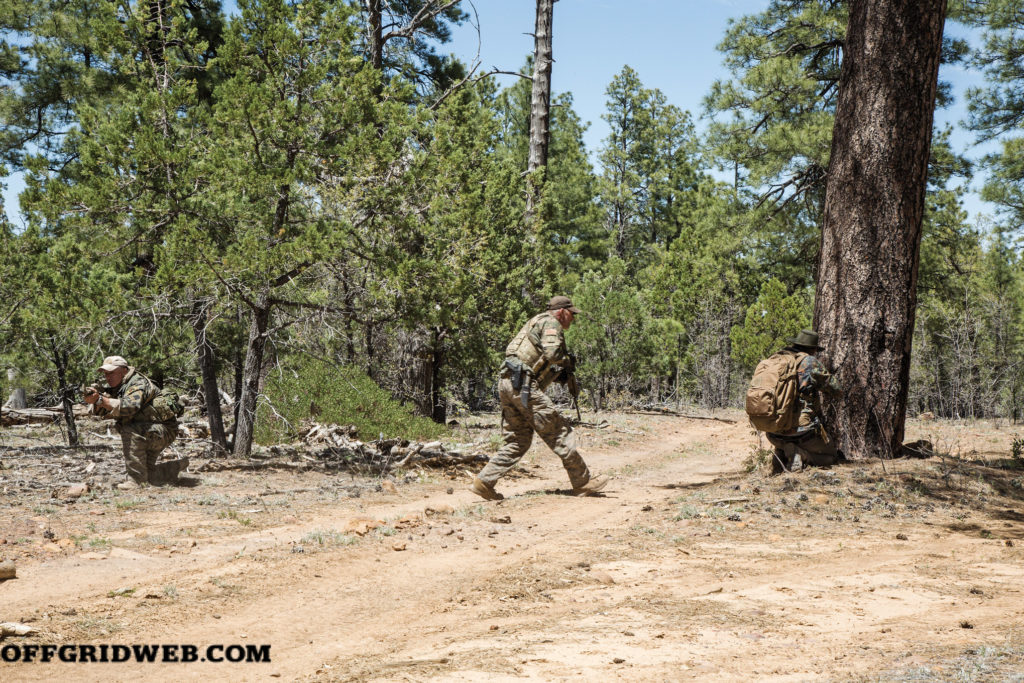
Above: Linear danger areas, such as this dirt road, were crossed one by one using the “bump” technique. Both sides of the LDA were covered at all times.
As we crossed into hostile territory, our patrol group moved through the trees in a linear formation as described above, keeping an eye out for anything that might alert the enemy of our presence. This included clearings, riverbeds, animal tracks, or open trails that made us more visible — these are known as Linear Danger Areas (LDAs). If the Point Man came across this type of obstacle, he stopped and allowed the linear formation to collapse on his position. The PL made a decision between two crossing strategies:
Rush across: Two patrol members set up security looking up and down the LDA, respectively, while the rest of the group moves quickly across in a single motion. This is fast, but incurs a higher risk penalty due to increased noise and exposure.
Bump across: Point Man covers one end of the LDA, then the Slack Man gives him a physical bump, at which point he quickly crosses to cover the far side, turning to face the opposite end. The next group member bumps the Slack Man across, who takes up the Point Man’s cover position, and so on. Once all members have crossed and rallied, the formation is resumed.
Group members were also cautious around areas with dense brush that might rustle or twigs that might snap underfoot. We learned to walk in a smooth manner, slowly rolling weight from heel to toe with each step to minimize noise. High crawl (with head up) and low crawl (with head down in the dirt) were employed as we got close to the objective.
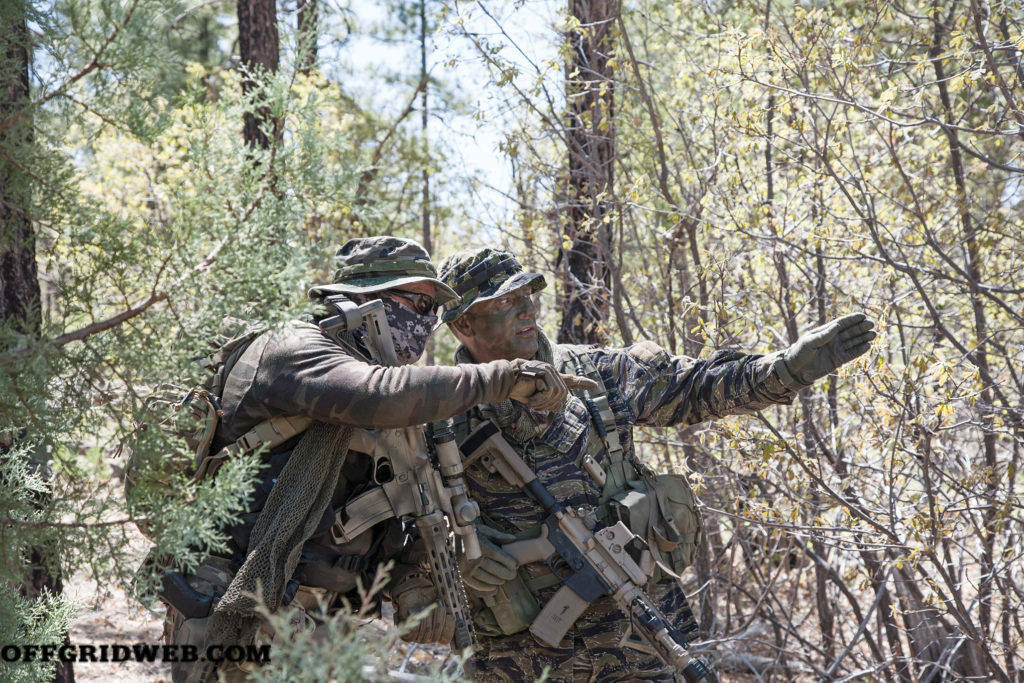
Above: Verbal communication was kept to a minimum during the patrol. The few words that were spoken were kept to a barely audible whisper.
Reconnaissance Team White Mountain proceeded through the hostile zone, periodically collapsing our linear formation at rally points along the way. To indicate a rally point, a group member moves his hand in a circular stirring motion. Each member closest to him silently passes this signal along the line, then the group gathers around the Point Man, who selects a concealed and defensible position. All members face outward in a circle, maintaining 360-degree security. Rally points were used to sit and rest, drink water, check maps, reapply camouflage paint, communicate with the PL in barely audible whispers, and most importantly, listen. It’s amazing what five minutes of total silence can tell you about your surroundings — sound carries much farther than you might expect, whether it’s chirping birds, the trickle of a nearby creek, or the distant burble of a two-stroke engine. The latter sound was audible as we neared our objective, telling us that the reports of our enemy using side-by-side vehicles were correct.
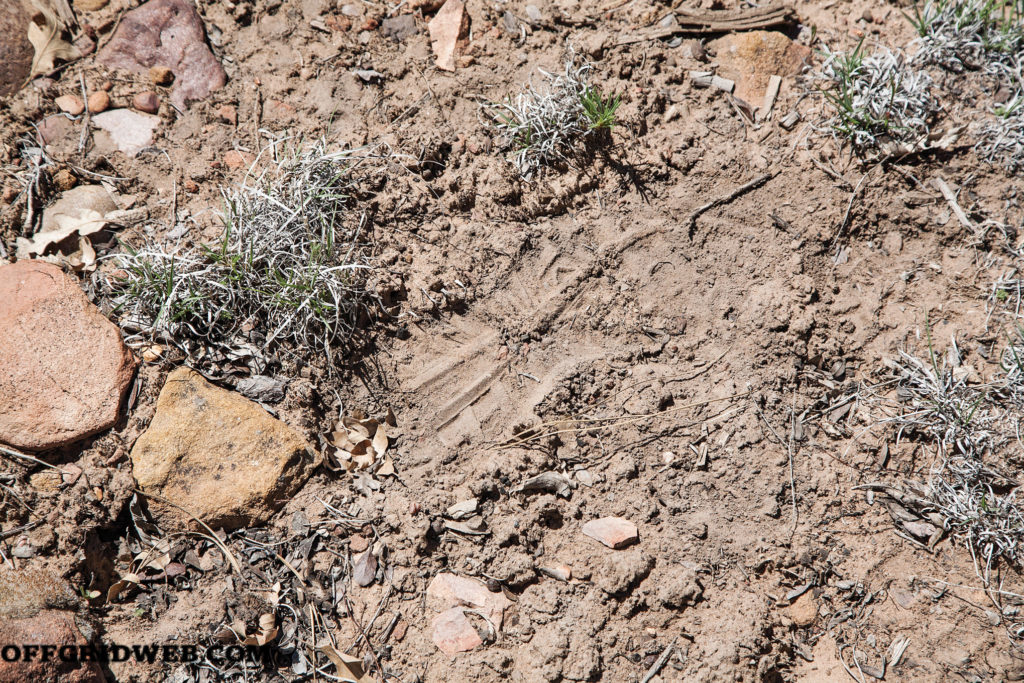
Above and Below: On a recon patrol, your eyes should be constantly scanning the environment, including the ground. It’d be easy to overlook deadfall twigs that could give away your position, or a footprint that could warn you of recent human activity.
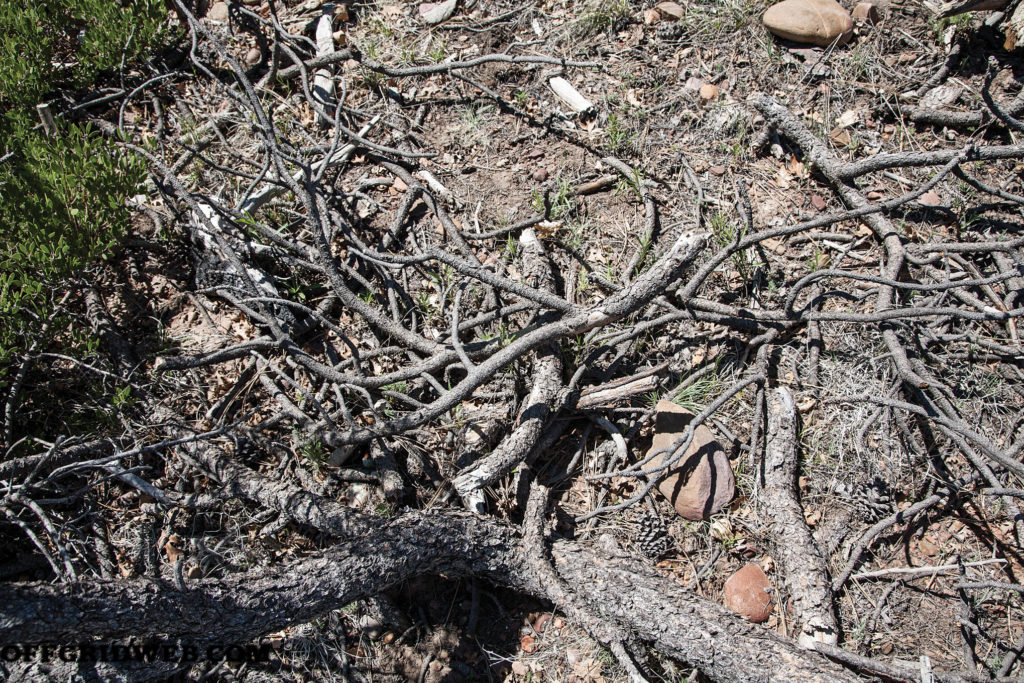
During the planning phase, we had used our topographic maps to mark an ORP near a good vantage point a few hundred yards from the objective hilltop. As we approached this area, our PL pointed out a shaded position surrounded by thorny brush that would serve as our ORP. All members took up 360-degree security positions beneath a tree, but this time offloaded our patrol packs. We would approach the objective with only the bare necessities: rifles, chest rigs, and binoculars.
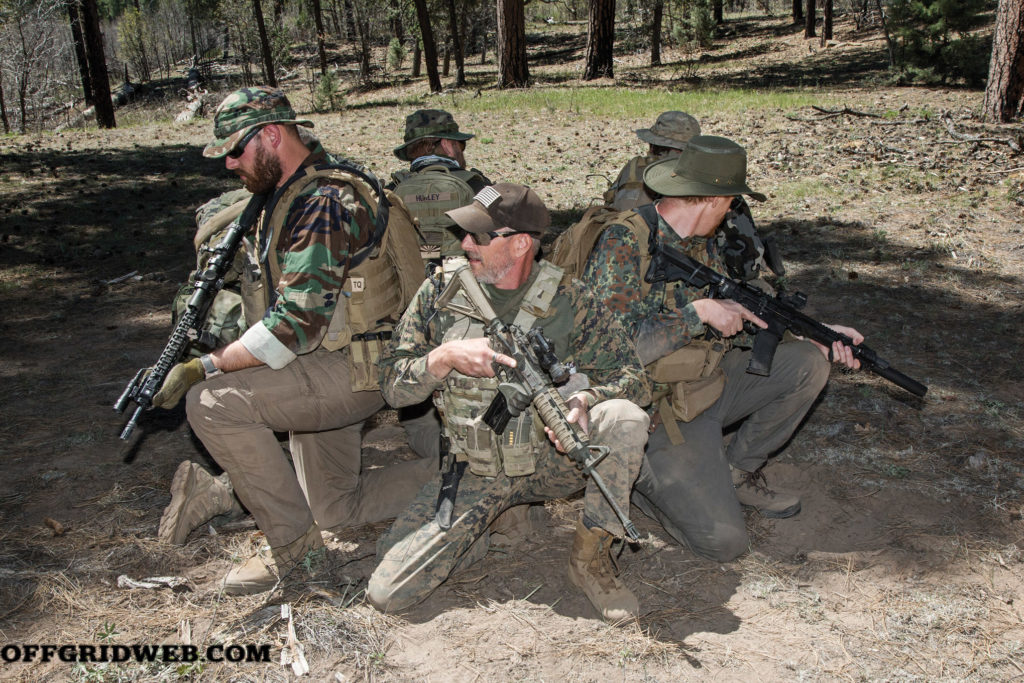
Above: At rally points, patrol group members formed a tight circle to maintain 360-degree security.
The first step of the reconnaissance process was a leader’s recon of the objective. Our PL took one member of the team and moved closer to the objective with the utmost caution. They noted some rocky outcroppings that would provide visibility of the hilltop, but also offer cover and concealment for the team as we approached. The duo returned to the ORP, whispered the plan to us, and confirmed that everyone was ready to move in.
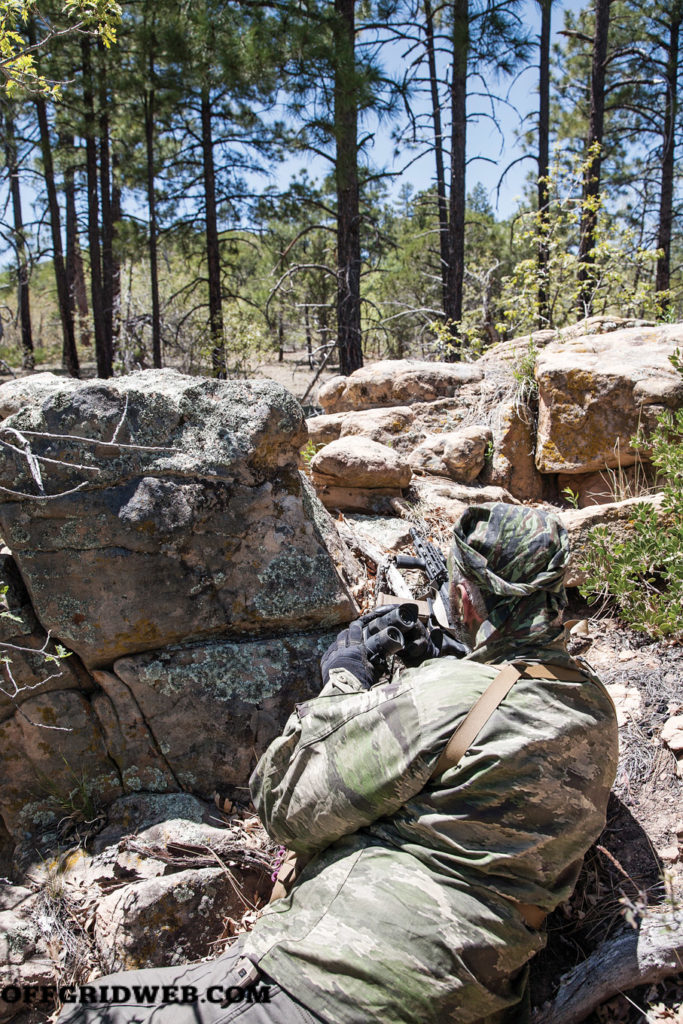
At high noon, the members of RT White Mountain moved close enough to surveil the objective. We crawled up the rocks, taking care to avoid any noise or direct line of sight to the enemy position. Peering through our binoculars and rifle scopes, we could see two men silhouetted on the hilltop along with the side-by-side they arrived in. They spoke casually with each other and occasionally scanned the area with their own binos. Just as the reports indicated, we confirmed that they were dressed in camouflage, and armed with rifles and a mortar tube.
Now that our recon was complete, we returned to the ORP and gathered to disseminate information in whispered voices. This is crucial, since it ensures that all intel will make it back to base even if some members of the team are captured or killed. The SALUTE format was used to record key details about the enemy:
Once we agreed on all the facts, avoiding uncertain “I think I saw …” statements, it was time to collect our gear and get moving again.
It’s easy to let your guard down and move quickly at this stage, but that could be a fatal error. Exfiltration should be just as slow and methodical as insertion. As we left the ORP, we retraced our path, bumped across LDAs, and formed up at rally points to rest and observe just as we had earlier in the day. Mental and physical fatigue is high after a mission, and this can lead to heavy footfalls, poor attentiveness, and inconsistent spacing in the formation. Each member of the patrol group kept an eye on his teammates to ensure we stayed focused on the task at hand.
Finally, once we had all safely returned to our patrol base and campsite, Lacy debriefed the students. In our
after-action report (AAR), we shared everything we observed and learned about the enemy during our recon patrol. Since this was a simulation, we also had the benefit of being graded by the instructors who played our enemy. Just as a real enemy would, they had been scanning the area around their hilltop position throughout the morning and had focused their attention on regions they considered the most likely approach points. They hadn’t seen or heard us at all, but we had accurately reported their presence — our recon mission was successful.
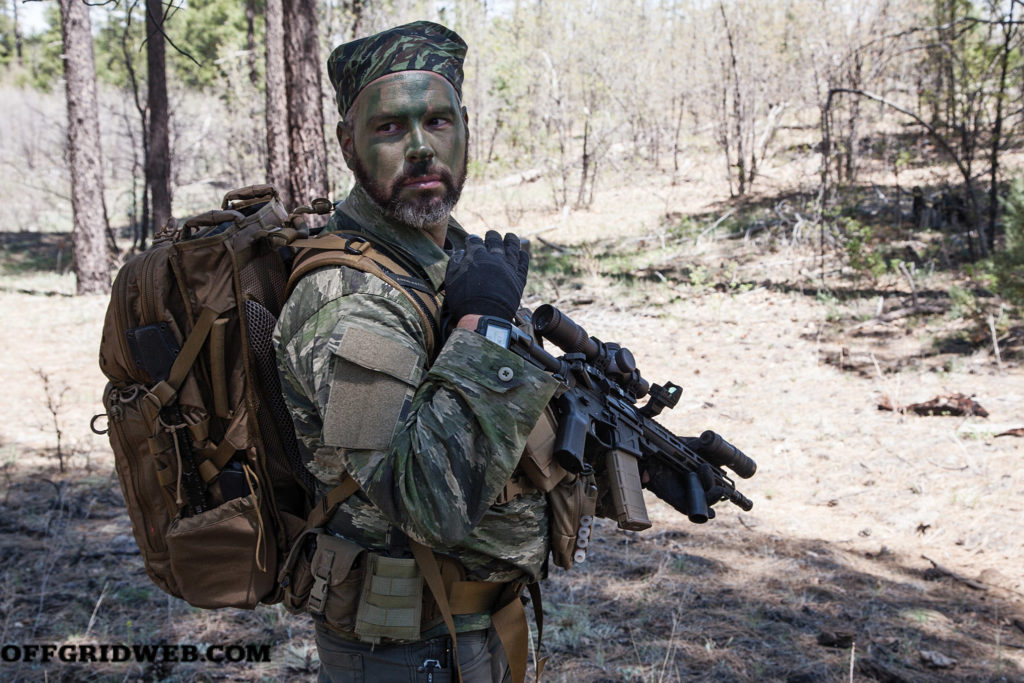
Above: Hand signs were used to communicate without making a sound. The “slit throat” gesture indicates a danger area ahead.
Lacy said that his courses are always evolving, and that future scenarios will have more curveballs. The enemy might set up booby trap alarms, establish secondary outposts, or send patrols of their own to hunt for students. There could even be a nighttime scenario that incorporates night vision equipment. We hope to take another Guerrilla Mentor class in the future to see how we fare against these challenges.
As we packed up and left the Rural Recon class, we were struck by the significance of this experience. Some people will undoubtedly roll their eyes at the idea of civilians sneaking through the woods with rifles and head-to-toe camouflage, claiming that this is a skill we’ll never need to use. They may be right about that, and frankly, we hope they are. But in the event of another war on American soil — an inevitability, whether it happens in our lifetime or hundreds of years in the future — it’s impossible to deny the advantage of having firsthand experience with small-unit guerrilla tactics. Reconnaissance patrols are an invaluable means of learning about your enemy, and this information can be the deciding factor between victory and defeat, especially in an asymmetric war.
Certain reconnaissance missions may require an overnight stay in hostile territory. In these instances, a Remain Over Night (RON) position will be established and occupied, allowing each team member to briefly rest, eat, and maintain their gear.
When the PL identifies a viable RON position, he uses “look there” hand signals to indicate it to the group. Rather than stopping immediately, the group moves past the position at a safe distance, and loops around to approach from the far side. This is known as a fishhook maneuver, and it clears the perimeter before the position is occupied.
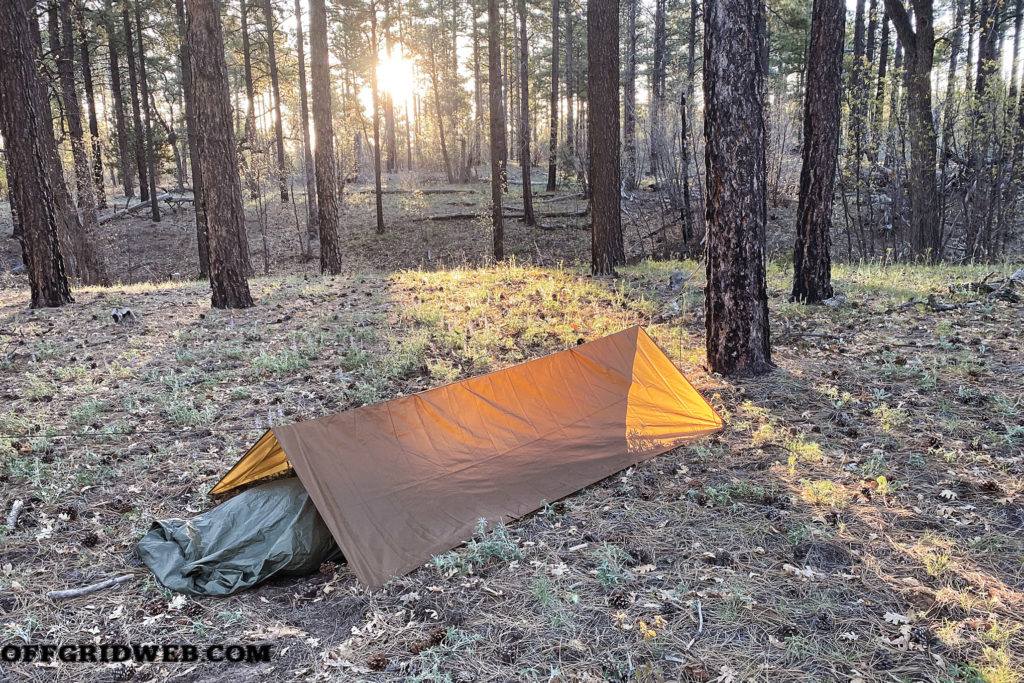
Above: To reinforce the reality of sleeping in the field, students were told not to bring tents. This author’s sleep system consisted of a Softie Tactical 2 sleeping bag, waterproof Bivvi bag, Basecamp Ops Maxi Mat, and Stasha tarp, all sourced from SnugPak USA.
The team lies face down in a circle, looking outward with boot-to-boot contact in the center. Each member sleeps in shifts, waking or alerting his neighbors by touching his boot to theirs. If nature calls, he rolls onto one side, digs a small hole to urinate into, and covers it with dirt before lying down again. Once it’s time to leave, the RON position should be swept with a branch to cover depressions in the soil or other signs of activity.
 STAY SAFE: Download a Free copy of the OFFGRID Outbreak Issue
STAY SAFE: Download a Free copy of the OFFGRID Outbreak Issue
No Comments